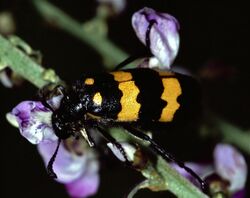Biology:Mylabris phalerata
| Mylabris phalerata | |
|---|---|

| |
| Scientific classification | |
| Domain: | Eukaryota |
| Kingdom: | Animalia |
| Phylum: | Arthropoda |
| Class: | Insecta |
| Order: | Coleoptera |
| Infraorder: | Cucujiformia |
| Family: | Meloidae |
| Genus: | Mylabris |
| Species: | M. phalerata
|
| Binomial name | |
| Mylabris phalerata (Pallas, 1781)
| |
Mylabris phalerata is a species of blister beetle, belonging to the Meloidae family. Known as the Chinese blister beetle or the banded blister beetle, it is used in traditional Chinese medicine.[1][2]
Morphology
The adults of this species range from 25 mm to 34 mm long and 4 mm wide, with the average length of females being 33 mm and the average length of males being 26 mm.[3] The adult beetles are black with large orange spots behind their head, followed by 2 wider orange bands.[3]
The eggs of this species are smooth, orange, and banana shaped.[3]
Life cycle
This species lays eggs in the soil in August, and roughly 40 days later, in mid-September, the eggs hatch.[3] The larvae go through five stages before they mature into an adult, the last being their overwintering stage, in which they spend six months in the soil before pupating in May and emerging in June as adults.[3] Their developmental temperature range is 18 °C to 34 °C.[3] The amount of time spend during their overwinter stage is determined by soil temperature.[4]
Geographic distribution
Mylabris phalerata is widely distributed in India and southern China; however, it is now scarce.[5][4][6]
Impact
When population levels are high, M. phalerata can be important pests of the flowers of the cowpea plant; they will destroy flowers and chew holes in the young pods.[3]
Medical and research use
Mylabris phalerata was traditionally used in Chinese medicine to treat tumors, carbuncle, scrofula, poor blood circulation, pleurisy, dropsy, pericarditis, and missed menstrual periods.[5][3] Some side effects of the crude medicine obtained from M. phalerata can cause abdominal pain and hemorrhagic shock.[7]
Today, M. phalerata is used for its chemical components, primarily cantharidin.
A fatality from cantharidin poisoning has been reported in which dried beetles had been used as an abortifacient.[8]
References
- ↑ Nakatani, T.; Konishi, T.; Miyahara, K.; Noda, N. (2004). "Three novel cantharidin-related compounds from the Chinese blister beetle, Mylabris phalerata Pall." (pdf). Chemical and Pharmaceutical Bulletin 52 (7): 807–809. doi:10.1248/cpb.52.807. PMID 15256700. https://www.jstage.jst.go.jp/article/cpb/52/7/52_7_807/_pdf.
- ↑ "Banded Blister Beetle". https://www.projectnoah.org/spottings/1292226003.
- ↑ 3.0 3.1 3.2 3.3 3.4 3.5 3.6 3.7 Zhu, F; Lei, CL; Xue, FS (December 2005). "The morphology and temperature-dependent development of Mylabris phalerata Pallas (Coleoptera: Meloidae)". The Coleopterists Bulletin 59 (4): 521–527. doi:10.1649/838.1.
- ↑ 4.0 4.1 Zhu, Fen; Xue, Fangsen; Lei, Chaoliang (3 July 2006). "The effect of environmental conditions on diapause in the blister beetle, Mylabris phalerata (Coleoptera: Meloidae)". European Journal of Entomology 103 (3): 531–535. doi:10.14411/eje.2006.069.
- ↑ 5.0 5.1 Deng, Yuan-Yuan; Zhang, Wei; Lei, Xue-Ping; Zhang, Dong-Mei; He, Jun; Wang, Lei; Ye, Wen-Cai (1 August 2017). "Four new cantharidin derivatives from the Chinese blister beetles, Mylabris phalerata". Heterocycles 94 (8): 1573–1581. doi:10.3987/COM-17-13722.
- ↑ Dattagupta, Anup; Nath, Susanta (December 2010). "Behavioural study of Mylabris phalerata (Meloidae: Coleoptera) in field and laboratory conditions". Proceedings of the Zoological Society 63 (2): 141–143. doi:10.1007/s12595-010-0020-6.
- ↑ Huh, JE; Kang, KS; Ahn, KS; Kim, DH; Saiki, I; Kim, SH (12 September 2003). "Mylabris phalerata induces apoptosis by caspase activation following cytochrome c release and Bid cleavage". Life Sciences 73 (17): 2249–2262. doi:10.1016/s0024-3205(03)00568-x. PMID 12927594.
- ↑ Cheng, K. C.; Lee, H. M.; Shum, S. F.; Yip, C. P. (1990). "A fatality due to the use of cantharides from Mylabris phalerata as an abortifacient". Medicine, Science and the Law 30 (4): 336–340. doi:10.1177/106002809003000410. PMID 2263179.
Wikidata ☰ Q6947613 entry

